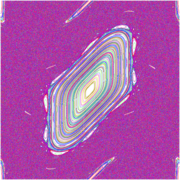Chirikov-Taylor standard illustration
The Tschirikow-Taylor standard mapping , Tschirikow standard mapping or standard mapping for short is the two-dimensional, area-preserving, iterative mapping
It is a simple Hamiltonian dynamic system that exhibits chaotic behavior and is therefore an important model system in the study of Hamiltonian chaos. The default picture is inter alia the Poincare section of a periodically initiated rotator ( English kicked rotator ), wherein the angle of the rotator, the pulse and a parameter for describing the strength of the periodic shock is. The illustration is named after the theoretical physicists Boris Valerianowitsch Tschirikow and John Bryan Taylor .
properties
The value corresponds to a rotator without periodic drive, in which the angular momentum is preserved and the angle changes at a constant speed. The phase space of the standard mapping then consists of horizontal lines. For values , the standard mapping has an elliptical fixed point at (in the middle of the figure) and a hyperbolic point at (at the edge of the figure).
At the separatrix , which would run through the hyperbolic fixed point and separate the circular movement around the elliptical fixed point from the movement along the horizontal lines, chaotic trajectories form with increasing values . The so-called chaotic sea, however, is interrupted by stable islands. This is a universal behavior of area-preserving, chaotic, smooth images , which is why many chaotic systems can be reduced to the standard image .
For each periodic orbit a number of rotation can be found
define where the high uplift of the standard image to a homeomorphism on and an arbitrary starting point. For rational values the orbit is periodic with period . Closed orbits, also called KAM orbits or KAM tori, prevent chaotic trajectories from freely diffusing through the entire phase space . It can be shown that with increasing values of the KAM orbits are destroyed first, the rotation number of which can best be approximated by means of continued fraction decomposition by rational numbers. The KAM orbit, which is the last to be destroyed, has the number of rotation equal to the golden ratio and is therefore also called the golden KAM torus. This torus is destroyed at one value .
- Phase space of standard mapping; 5000 iterations of 1000 random points are shown
Web links
Individual evidence
- ↑ RSMacKay, "A renormalization approach to invariant circles in area-preserving maps", Physica D 7 (1-3): 283 (1983).
































